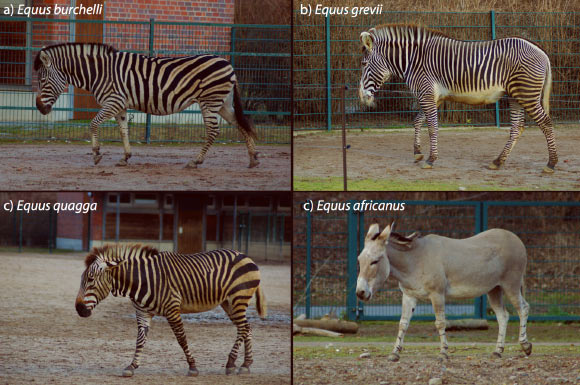In a study published online in the journal PLoS ONE, scientists found that zebra stripes cannot be involved in allowing the animals to blend in with the background of their environment, because at the point at which predators can see a zebra’s stripes, they probably already have heard or smelled their zebra prey.

Photographs of (a) plains, (b) mountain, and (c) Grevy’s zebra, and (d) African wild ass in the Tierpark Zoo, Berlin. Image credit: Tim Caro.
“The results from this new study provide no support at all for the century-old idea that the zebra’s stripes provide some type of anti-predator camouflaging effect. Instead, we reject this hypothesis that was debated by Charles Darwin and Alfred Russell Wallace,” said study senior author Prof. Tim Caro, from the University of California Davis’ Department of Wildlife, Fish and Conservation Biology.
To test the camouflaging hypothesis, Prof. Caro and co-authors passed images taken in the field in Tanzania through spatial and color filters that simulated how the zebras would appear to their main predators – lions and spotted hyenas – as well as to other zebras.
“We evaluated this hypothesis by passing digital images of zebras through species-specific spatial and color filters to simulate their appearance for the visual systems of zebras’ primary predators and zebras themselves,” the scientists said.
“We also measured stripe widths and luminance contrast to estimate the maximum distances from which lions, spotted hyenas, and zebras can resolve stripes.”
They found that beyond 165 feet (50 m) in daylight or 98 feet (30 m) at twilight, when most predators hunt, stripes can be seen by humans but are hard for zebra predators to distinguish. On moonless nights, the stripes are particularly difficult for all species to distinguish beyond 30 feet (9 m).
“Our analyses indicate that, under daylight conditions, humans can resolve zebra stripes at considerably greater distances than can large carnivores or zebras, but that all four observer types perform in a roughly equivalent fashion under scotopic conditions,” they said. “Under photopic conditions, however, humans can resolve stripes at distances 2.6 times greater than that of zebras, and at 4.5 and 7.5 times the distances of lions and spotted hyenas, respectively.”
“Stripe visibility decreases dramatically as light falls. At dusk, when hunting by carnivores normally begins, humans can resolve stripes from greater distances than other mammals: 3 times those of lions, 5 times further than spotted hyenas, and 1.9 times more distant than zebras.”
“Under such mesopic conditions, we project that lions can discern stripes at 82-184 feet (25-56 m) and hyenas at 49-112 feet (15-34 m), but beyond these distances zebras’ bodies simply appear grey. Under scotopic conditions, the four species have similar spatial vision and so need to be very close to see stripes. For a lion, it can resolve the widest stripes at only 20-46 feet (6-14 m), and a spotted hyena at 13-30 feet (4-9 m).”
This suggests that the zebra stripes don’t provide camouflage in woodland areas, where it had earlier been theorized that black stripes mimicked tree trunks and white stripes blended in with shafts of light through the trees.
And in open, treeless habitats, where zebras tend to spend most of their time, the team found that lions could see the outline of striped zebras just as easily as they could see similar-sized prey with fairly solid-colored hides, such as waterbuck and topi, and the smaller impala.
It had been earlier suggested that the striping might disrupt the outline of zebras on the plains, where they might otherwise be clearly visible to their predators.
In addition to discrediting the camouflaging hypothesis, the study did not yield evidence suggesting that the striping provides some type of social advantage by allowing other zebras to recognize each other at a distance.
_____
Melin A.D. et al. 2016. Zebra Stripes through the Eyes of Their Predators, Zebras, and Humans. PLoS ONE 11 (1): e0145679; doi: 10.1371/journal.pone.0145679







